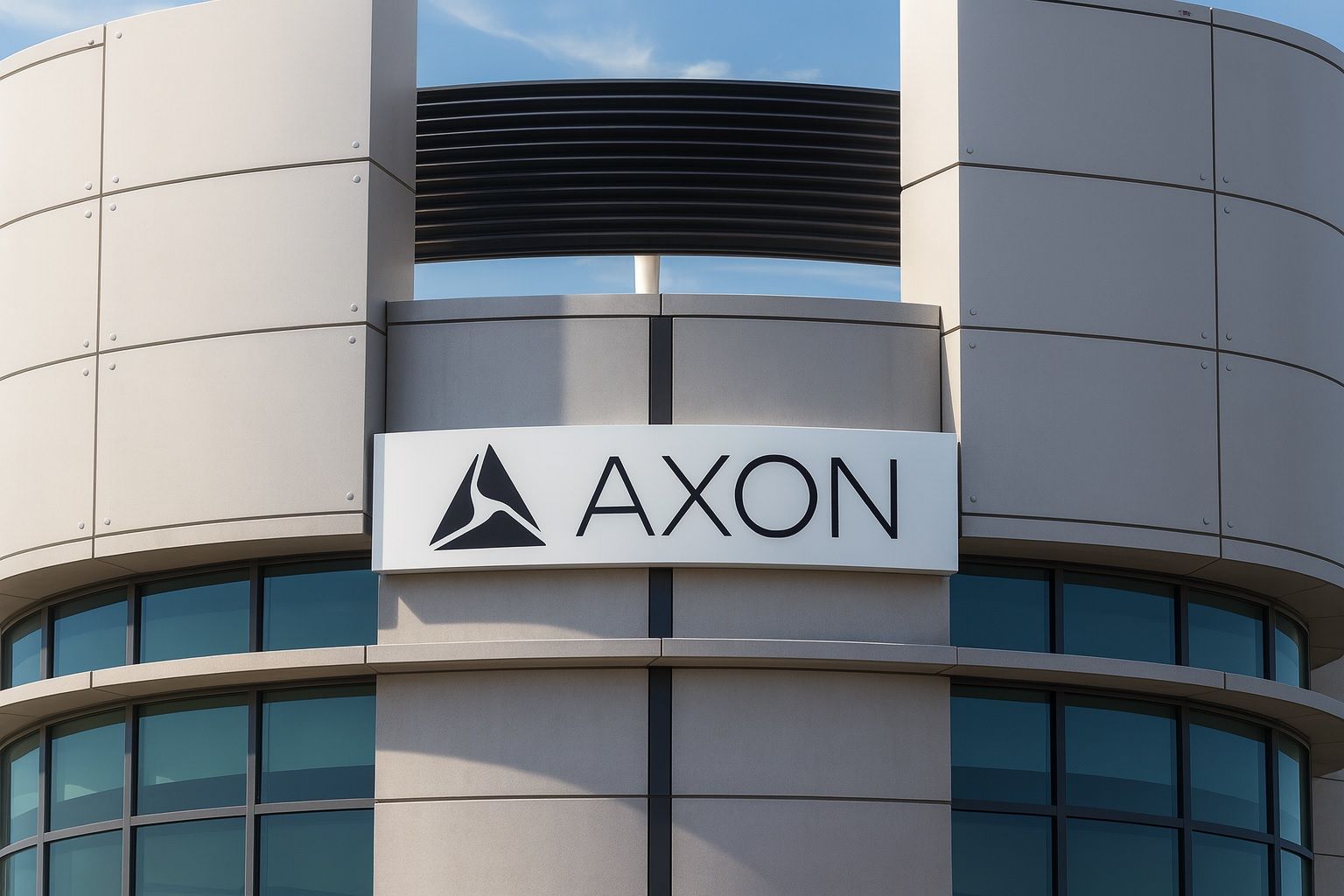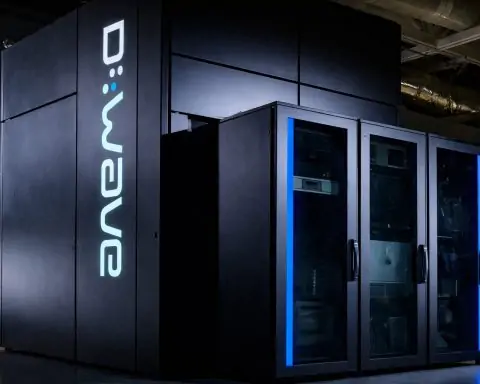- Volatile Surge: Axon Enterprise (NASDAQ: AXON) saw extreme trading action this week. In London, its thinly-traded shares spiked an astonishing +420.8% in one day – from around £131 to nearly $683 [1] – likely due to low liquidity rather than fundamentals. In U.S. trading, Axon’s stock rebounded to about $701 after a recent dip, and remains up ~62% year-over-year [2] [3].
- Recent Pullback: Just days ago Axon slid 8.5% in a single session, closing at $644.99 on a profit-taking wave [4]. This drop undercut its 200-day moving average (~$677) and stood out as the broader market climbed [5] [6]. Analysts noted no negative news to justify the plunge – suggesting technical factors and traders locking in gains after a 60% 12-month rally [7]. By the next day, bargain hunters stepped in and shares bounced ~2% [8]. “Given the lack of a clear negative catalyst, the recent weakness could offer a buying opportunity for long-term investors,” one analyst observed [9].
- Red-Hot Growth: Axon’s financials are surging. Last quarter (Q2 2025) revenue jumped +32.6% YoY to $668.5 million, beating estimates handily [10]. Adjusted earnings were $2.12 per share (vs. $1.54 expected) [11]. Buoyed by strong demand for Axon’s Tasers, body cameras, and cloud software, management raised full-year revenue guidance to $2.65–2.73 billion (~+29% YoY) [12] [13]. Few companies its size sustain ~30% annual growth, a pace that underscores booming interest in public safety tech.
- AI & Expansion Moves: Axon is rapidly evolving beyond Tasers into a full-stack public safety platform [14]. Just this week, it announced plans to acquire Prepared – an AI-powered 911 dispatch software firm – in an ~$800M deal [15]. Needham analysts praised the move as a “significant opportunity” to improve emergency response and “save both financial costs and lives” with better tech [16]. Axon also unveiled a new AI-enabled “Workforce” body camera for retail and healthcare staff [17], and partnered with TYTAN to bolster its Dedrone counter-drone defense system [18] [19]. Meanwhile, Arizona approved a $1.3B new headquarters campus for Axon – a “defining moment,” says CEO Rick Smith – though local zoning challenges could delay it [20].
- Bullish Wall Street: Despite recent volatility, analysts remain overwhelmingly bullish. 14 out of 18 analysts rate AXON a “Buy” (4 Hold, 0 Sell) [21] [22]. The average 12-month price target is ~$842, implying ~20%–30% upside [23] [24]. Top firms have issued even higher targets: Needham reiterated a $870 target after the Prepared deal [25], Morgan Stanley and Piper Sandler each cite ~$885 [26], and Bank of America is eyeing $1,000 in a bull-case scenario [27] [28]. JMP Securities likewise calls Axon “Outperform” with an $825 goal, calling the Prepared acquisition “a perfect complement” to Axon’s ecosystem [29] [30]. Even TV pundits are optimistic – CNBC’s Jim Cramer recently lauded Axon as a company that “could continue to rally” given its pivotal role in AI-driven security [31].
- Valuation & Outlook: The only red flag is Axon’s sky-high valuation. Trading around 100× forward earnings (175× trailing) [32] [33], the stock is priced for rapid growth. This rich multiple has prompted some caution – for example, Zacks Investment Research holds a neutral rating on Axon due to its premium valuation [34]. However, bulls argue Axon’s growth justifies the price: the company dominates U.S. law enforcement (serving ~95% of police departments) [35] and is expanding into new markets with first-mover advantage in AI public safety tech. Investors will get more insight soon – Axon is slated to report Q3 2025 earnings on November 4, 2025 [36], which could be a catalyst for the next leg up (or a reality check) depending on whether Axon continues its streak of beating expectations.
Axon’s Wild Ride: From Plunge to 420% Pop Abroad
Axon’s stock has been on a rollercoaster in late October. Last week, shares suddenly plunged ~8.5% in one day, falling from the $700s to about $645 [37]. Notably, this dive occurred despite no major negative news from the company – a stark contrast to the modest uptick in the broader market that day [38]. Market watchers suggest the drop was triggered by technical trading: the sell-off pushed AXON below a key support (its 200-day average), likely triggering stop-loss orders and momentum selling [39]. Indeed, analysts at TheStreet “do not see any developments” with Axon or its rivals to fundamentally justify such a decline [40]. In other words, it appears some investors simply took profits after Axon’s tremendous run-up over the past year (shares had climbed ~60% year-on-year before the dip) [41].
The good news for shareholders: the slump was short-lived. By the very next trading day, bargain hunters swooped in, and Axon’s stock bounced roughly +2%, clawing back a chunk of the loss [42]. As of Wednesday’s close, AXON was back around $701 [43], keeping it +8–9% year-to-date in 2025 [44]. The swift recovery suggests many investors viewed the pullback as overdone. In fact, several experts framed the dip as a chance to buy. With no “clear negative catalyst” behind the sell-off, the weakness “could offer a buying opportunity for long-term investors,” one market analyst noted optimistically [45].
Meanwhile, Axon made headlines overseas with a truly eye-popping swing. On Monday, the company’s UK-listed shares (ticker LON:AXON) temporarily skyrocketed over 420% in a single session [46]. The stock, which had closed around £131, inexplicably surged to as high as $683 during London trading [47]. Volume was extremely low (just ~8,300 shares traded vs. an average 726,000 [48]), suggesting this was an anomaly – likely one errant trade or data glitch rather than a massive influx of new buyers. Still, the dramatic 420% jump turned heads and underscored the intense global attention on Axon’s stock. It’s a reminder that Axon’s momentum has attracted interest far beyond U.S. markets – and occasionally, some strange market dynamics when liquidity is thin.
High Growth Fueled by Tech & Innovation
Wild price swings aside, the underlying story for Axon Enterprise is robust growth and a rapidly expanding business model. The company has dramatically transformed from its early identity as “that Taser maker” into a diversified, high-tech force in public safety. As one recent bullish analysis put it, Axon is evolving from a conducted energy weapons manufacturer into a full-stack public safety technology platform [49]. That evolution is clearly reflected in Axon’s financial results and strategic moves.
Booming Financials: Axon’s latest earnings report (Q2 2025) showcased red-hot demand for its products. Revenue soared about 33% year-on-year to $668.5 million [50] – a record quarter that blew past the ~$643M consensus estimate. The company’s growing software and cloud services (like its Evidence.com platform for managing police video/data) continue to complement strong hardware sales of TASER devices and body cameras. Profits are rising swiftly as well: Axon delivered $2.12 in adjusted earnings per share, crushing expectations of $1.54 [51]. After such a strong quarter, Axon’s management didn’t shy away from optimism – they hiked full-year 2025 revenue guidance to roughly $2.7 billion [52], which would mark ~29% growth over 2024 [53]. It’s worth noting that sustaining ~30% growth on a multi-billion-dollar revenue base is a rare feat. Axon’s ability to do so highlights its execution and the burgeoning market for public safety and law enforcement tech.
AI and Acquisitions: A key driver behind Axon’s growth is its aggressive push into artificial intelligence and software. In recent days, Axon announced a string of moves that broaden its reach:
- The company is acquiring Prepared, a six-year-old tech firm that specializes in AI-enabled 911 emergency dispatch software. Prepared’s platform can integrate live video, texts, GPS, and even real-time translation for 911 call centers [54]. This deal (worth at least $800M, per reports) gives Axon a foothold in the emergency communications space that it has long eyed. Analysts at Needham & Co. cheered the move, calling it a “significant opportunity” for Axon to improve 911 response and potentially “save both financial costs and lives” with more efficient technology [55]. In effect, Axon is extending its platform to cover the initial call-for-help stage of public safety, complementing its end-to-end coverage (from field devices to evidence management). Notably, Axon had tried to enter the 911 software arena in the past; now it’s doing so by buying an established player – a strategy JMP Securities’ Trevor Walsh calls “a perfect complement” to Axon’s prior software acquisitions [56].
- Axon also rolled out the Axon Body 4 “Workforce” Mini, a new lightweight body-worn camera designed not for police, but for retail, healthcare, and private security workers [57]. This device is “lighter, smarter, and powered by AI,” aimed at industries facing security risks (think hospital staff or store employees confronting shoplifting). By launching a product for the commercial sector, Axon is broadening its addressable market beyond its core law enforcement customer base.
- Additionally, Axon is investing in counter-drone capabilities. It recently partnered with TYTAN, a defense tech firm, to integrate a novel drone interceptor into Axon’s anti-drone systems [58]. Axon already has a stake in drone defense through its subsidiary Dedrone; the TYTAN tie-up adds new tech to help security forces track and disable hostile drones – a growing need for police and military clients. This underscores Axon’s strategy to be at the cutting edge of emerging threats (like rogue drones) and to offer a comprehensive “public safety operating system” spanning multiple domains [59].
Beyond tech, Axon is even expanding physically. The company’s rapid growth has prompted plans for a massive new headquarters. Arizona’s governor recently signed off on a package to support Axon’s proposed $1.3 billion HQ campus in Scottsdale [60], which Axon’s CEO Rick Smith hailed as crucial for the company to “continue to thrive” where it started. However, that plan isn’t without hiccups – the city of Scottsdale is challenging the state law enabling the campus (due to zoning and development concerns) [61]. For Axon, which has grown from a small Taser startup in a garage to a 4,000+ employee tech leader, the HQ saga will be one to watch. It symbolizes the company’s ambition to scale, but also the real-world hurdles that rapid expansion can bring.
Wall Street’s Take: Big Upside – If Axon Delivers
On Wall Street, Axon’s strong growth story has translated into strong investor optimism. The company has become a favorite in the tech and defense crossover space, and most analysts urge investors to buy on dips like the recent one. According to MarketBeat data, 14 of 18 analysts covering Axon rate it a “Buy”, with the rest on Hold and zero sells [62]. The consensus price target is about $840–$842 per share [63], roughly 20%–30% above the current ~$700 level. That consensus has been steadily rising as Axon continues to outperform. In late September, for instance, JMP Securities reaffirmed their bullish stance, maintaining an $825 target and Outperform rating [64]. Around the same time, J.P. Morgan and TD Cowen also reiterated positive outlooks [65]. More recently, when Axon announced the Prepared acquisition in October, several analysts boosted their targets further – Needham reiterated a $870 price target, highlighting Axon’s “strong financial health” and saying the 911 deal can deepen its dominance in public safety data [66]. And in an eye-catching call, Bank of America notched its bull-case target up to $1,000 for Axon [67] [68], implying the stock could potentially double from here in the coming years if everything goes right.
This bullish sentiment is echoed by market commentators as well. CNBC’s Jim Cramer recently singled out Axon as a name that “could continue to rally” thanks to its leading position at the intersection of AI and security [69]. Indeed, Axon’s ability to repeatedly post 30% growth and expand into new verticals has many convinced that the company’s best days are still ahead. As one investing columnist put it, Axon’s transformation into a broad public safety platform gives it multiple avenues for growth (from policing to emergency communications to private security), making it a play on the future of tech-enabled safety [70].
However, even bulls acknowledge one key risk: valuation. After its huge run, Axon trades at a lofty earnings multiple that bakes in a lot of future success. Based on guidance and analyst estimates, Axon’s forward price-to-earnings ratio is in the triple-digits (around 90×) and the trailing P/E is about 175× [71] [72]. For comparison, the S&P 500’s forward P/E is roughly 18×, and even other high-growth tech stocks often trade at a fraction of Axon’s multiple. This rich valuation means Axon will need to keep delivering high growth – and eventually strong profits – to grow into its stock price. It also leaves little margin for error; any slowdown or earnings miss could spur a sharp correction. This concern is why at least one cautious voice, Zacks, currently rates Axon only a “Hold,” citing the premium valuation despite the company’s strengths [73].
The Road Ahead
Going forward, Axon will have to prove that its ambitious expansion plans pay off. The upcoming Q3 2025 earnings report on Nov. 4 will be a crucial checkpoint [74]. Investors will look for continued high growth and any updates on the integration of new ventures like Prepared. They’ll also watch gross margins and cash flow, to ensure Axon’s growth (organically and via acquisitions) isn’t coming at the expense of profitability. Thus far, Axon’s track record is encouraging – e.g. 25%+ adjusted EBITDA margins for 14 straight quarters [75] – but Wall Street will expect that to continue or improve.
Another area to watch is competition. Axon’s near-monopoly on U.S. police tech (it supplies ~95% of domestic law enforcement agencies [76]) gives it a strong moat, but larger defense tech players are eyeing the space. Motorola Solutions, Axon’s biggest rival in body cams and radios, recently spent $4.4B to acquire a military communications firm [77], signaling its intent to deepen relationships with police and defense clients. While Axon doesn’t directly compete in that wireless niche, Motorola’s move ups the competitive ante and could encroach on Axon’s turf over time [78]. Axon will need to stay ahead by continuing to innovate (especially in AI) and by leveraging its first-mover advantage with cloud software and connected devices.
For now, the consensus on Axon Enterprise remains very positive. The company sits at the crossroads of several powerful trends – policing modernization, cloud and AI adoption in government, and even consumer safety tech – which could drive growth for years to come. That’s why the stock’s recent turbulence hasn’t shaken bullish experts. If anything, it’s given them a more attractive entry point. The dramatic 420% “surge” in Axon’s overseas listing may have been a fluke, but it symbolizes the outsized excitement around this name. With analysts pegging Axon’s future value in the $800s and $900s [79] (and one high-end target at $1,000 [80]), expectations are sky-high. Investors considering Axon now must believe in the company’s long-term vision: that Axon can keep revolutionizing public safety and justify its premium valuation. It’s a classic high-reward, high-volatility story – one where, as recent events show, the ride can get bumpy, but the destination could be well worth it.
Sources: Axon bull thesis and valuation stats [81] [82]; Insider analysis by TechStock² (TS2) on recent price moves, growth and deals [83] [84] [85] [86]; DefenseWorld market report on 420% London surge [87]; Wall St. analyst insights from TS2 and MarketBeat [88] [89]; Expert quotes from Needham, JMP, and Jim Cramer [90] [91] [92]; Yahoo Finance/InsiderMonkey on Axon’s platform pivot [93]; Axon press releases and earnings data [94] [95].
References
1. www.defenseworld.net, 2. ts2.tech, 3. finance.yahoo.com, 4. ts2.tech, 5. ts2.tech, 6. ts2.tech, 7. ts2.tech, 8. ts2.tech, 9. ts2.tech, 10. ts2.tech, 11. ts2.tech, 12. ts2.tech, 13. ts2.tech, 14. www.insidermonkey.com, 15. ts2.tech, 16. ts2.tech, 17. ts2.tech, 18. ts2.tech, 19. ts2.tech, 20. ts2.tech, 21. ts2.tech, 22. ts2.tech, 23. ts2.tech, 24. ts2.tech, 25. ts2.tech, 26. ts2.tech, 27. ts2.tech, 28. ts2.tech, 29. ts2.tech, 30. ts2.tech, 31. ts2.tech, 32. ts2.tech, 33. ts2.tech, 34. ts2.tech, 35. ts2.tech, 36. tickernerd.com, 37. ts2.tech, 38. ts2.tech, 39. ts2.tech, 40. ts2.tech, 41. ts2.tech, 42. ts2.tech, 43. finance.yahoo.com, 44. ts2.tech, 45. ts2.tech, 46. www.defenseworld.net, 47. www.defenseworld.net, 48. www.defenseworld.net, 49. www.insidermonkey.com, 50. ts2.tech, 51. ts2.tech, 52. ts2.tech, 53. ts2.tech, 54. ts2.tech, 55. ts2.tech, 56. ts2.tech, 57. ts2.tech, 58. ts2.tech, 59. ts2.tech, 60. ts2.tech, 61. ts2.tech, 62. ts2.tech, 63. ts2.tech, 64. ts2.tech, 65. news.futunn.com, 66. ts2.tech, 67. ts2.tech, 68. ts2.tech, 69. ts2.tech, 70. www.insidermonkey.com, 71. ts2.tech, 72. ts2.tech, 73. ts2.tech, 74. tickernerd.com, 75. ts2.tech, 76. ts2.tech, 77. ts2.tech, 78. ts2.tech, 79. ts2.tech, 80. ts2.tech, 81. www.insidermonkey.com, 82. www.insidermonkey.com, 83. ts2.tech, 84. ts2.tech, 85. ts2.tech, 86. ts2.tech, 87. www.defenseworld.net, 88. ts2.tech, 89. ts2.tech, 90. ts2.tech, 91. ts2.tech, 92. ts2.tech, 93. www.insidermonkey.com, 94. ts2.tech, 95. ts2.tech







